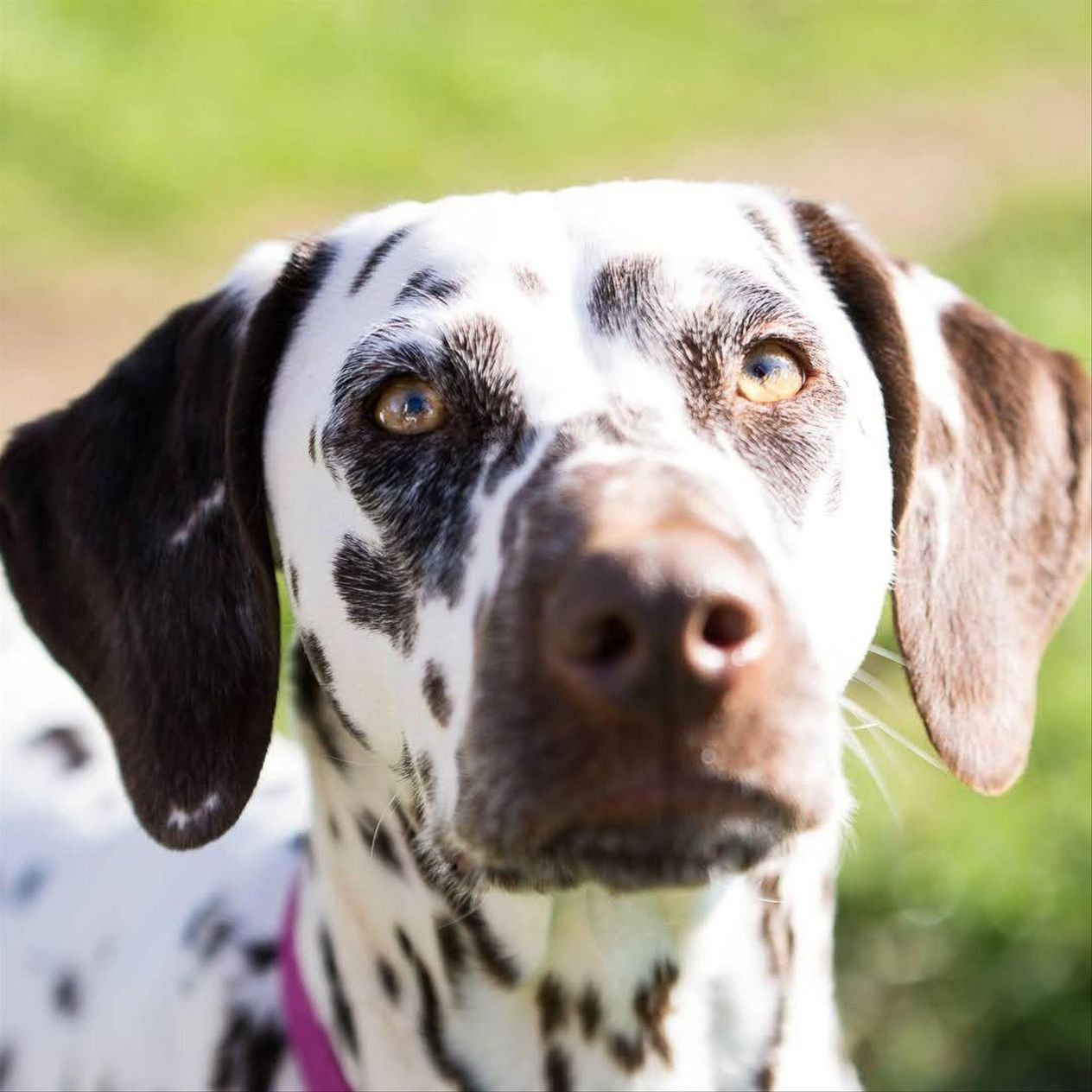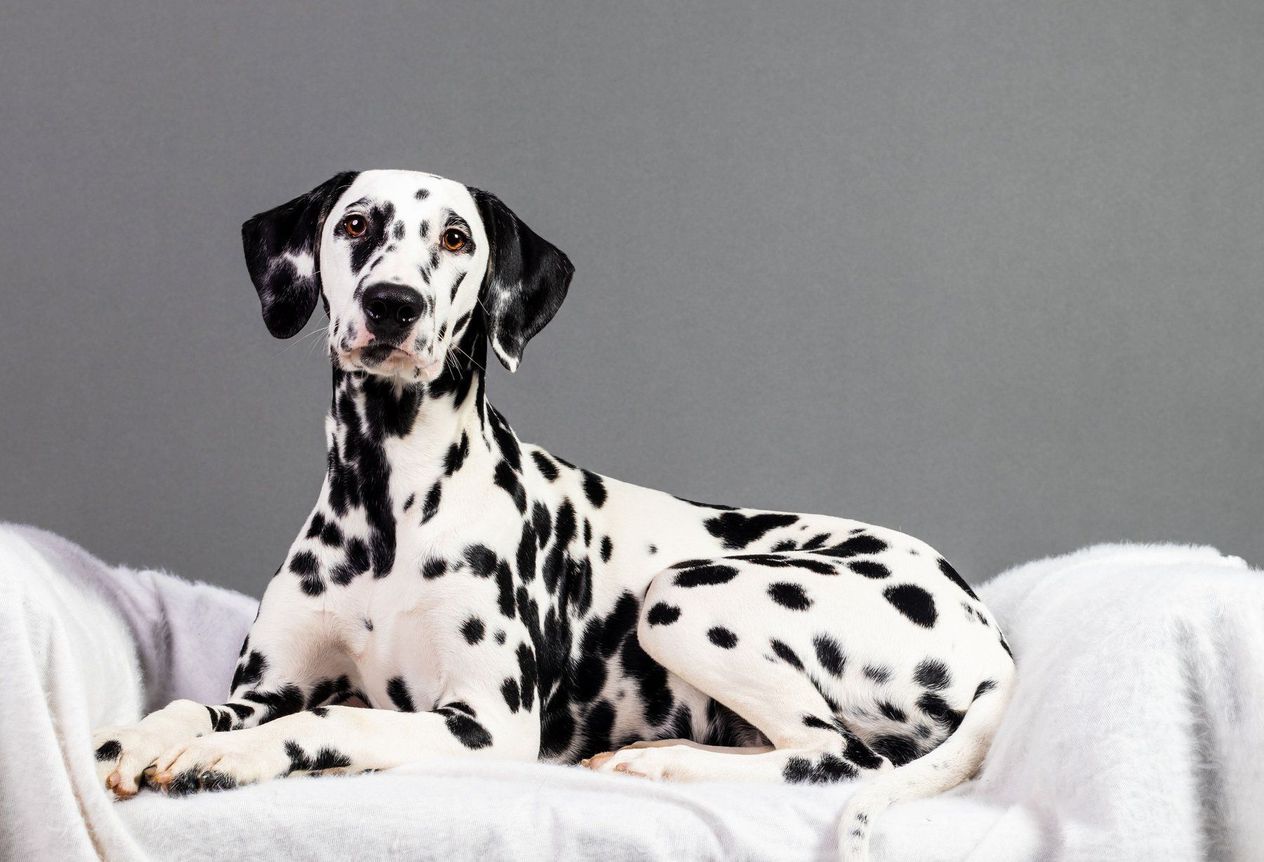Get to know
Dalmatians

Veterinarian reviewed
With the most distinctive coat pattern of the dog world, the Dalmatian is among the most recognizable—but mysterious—of breeds.
Browse available puppies
Connect with reputable breeders to find the dog of your dreams
At a glance
High Energy
Energy level
4/5
Minimal Maintenance
Grooming
1/5
Medium-large
Size
Playful, energetic, affectionate
Temperament
11-13 years
Lifespan
Average Trainability
Training
3/5
Medium Vocality
Barking
3/5
At a glance
Energy level
High Energy
Grooming
Minimal Maintenance
Size
Medium-large
Temperament
Playful, energetic, affectionate
Lifespan
11-13 years
Training
Average Trainability
Barking
Medium Vocality
Why people love the breed
Dalmatians are one of the most admired breeds in the world. After all, one evil character coveted their spotted coats so much she wanted to make a coat of her own from them! But 101 Dalmatians aside, Dals really do turn heads with their spotted coat unlike that of any other breed in the world. Of course, it’s their personality that those who know them really adore.
Appearance
Sleek and streamlined, the Dalmatian is built to trot for miles. It is a moderate breed with nothing in excess or exaggerated—except for these distinctive spots.
Grooming
Dalmatians are do-it-yourself wash-and-wear dogs.
Whispered Spots Dalmatians
Breed temperament and characteristics
Dalmatians are fun-loving and active. They are willing to please, but often get distracted and forget what they were supposed to be doing.
Exercise
The Dalmatian loves to exercise. They were bred to run for miles alongside carriages, and ideally, they would like to run miles alongside you. Budget at least an hour of running and playing, or two hours of walking, a day for young to middle-aged dogs.
Whispered Spots Dalmatians
Training
Dalmatians learn fast, but some also have a stubborn streak. With the right motivation, they can attain the highest levels of obedience. Just don’t try to force them—it won’t work.
Diet and nutrition
Some Dalmatians that tend to form urate crystals may need to eat special food to prevent that. And it’s especially important that they drink a lot of water.
Countryside Dalmatians
Health issues
Dalmatians are generally healthy, but they are known for being more prone to two health concerns: deafness and urinary stones.
Lifespan: 11 to 13 years.
High Uric Acid, Gout and Urinary Stones
Dalmatians have a higher risk of urate urinary stones than other breeds. The reason is because they have a condition called hyperuricemia (raised uric acid) where their livers don’t break down uric acid from purines in the diet properly. The increased level of uric acid builds up over time, forming into stones that cause urinary obstruction. In 1973, an unprecedented experiment called the Dalmatian/Pointer Backcross Project began. A geneticist crossed a purebred Dalmatian with a purebred Pointer. The offspring of this cross was then bred back to Dalmatians for every subsequent generation. The only difference was that in each generation only the dogs with the low uric acid (LUA), which they inherited from the Pointer, were bred. Eventually the only reminders of the cross were dogs with the low uric acid and a tendency for much smaller spots. Eventually the gene causing high uric acid was identified, making selection of the “LUA” dogs even easier. After considerable controversy, in 2011 the “LUA Dalmatians” were registered by the American Kennel Club (AKC), and now many have even earned championship titles. If you want to avoid hyperuricosuria in your Dalmatian, you should look for a breeder of LUA Dalmatians.
Deafness
Dalmatians have an increased risk of deafness compared to other breeds. Their deafness is hereditary and linked to a gene associated with their coat pattern. They are usually born with normal hearing but become deaf in one or both ears by a few weeks of age. Studies suggest between 18% and 30% of Dalmatians are deaf with 3% to 8% deaf in both ears. Some home tests may detect a puppy that is deaf in both ears, but can often miss one that is deaf in one ear. By five weeks of age a simple and painless Brainstem Auditory Evoked Response (BAER) test can detect deaf puppies.
History
About the author
Canine specialist, Caroline Coile, Ph.D., is the author of 34 dog books, including the top-selling Barron's Encyclopedia of Dog Breeds. She’s written thousands of magazine and web articles about dogs. She specializes in canine science, health, breeds and competitions. Caroline has won 20 national dog-writing awards, and was a 2015 Inductee into the Dog Writers Association of America Hall of Fame.
Veterinarian reviewed
Dr. Nate Ritter, DVM is the Veterinary Medical Director at Good Dog. He earned his Bachelor of Science in Biology from Lafayette College and his Doctor of Veterinary Medicine degree from Virginia-Maryland College of Veterinary Medicine. He is a member of the American Veterinary Medical Association, New York State Veterinary Medical Society, the Veterinary Medical Association of New York City, and the Society for Theriogenology. Additionally, he is a USDA-accredited veterinarian.
Breed Scorecard
Characteristics and temperament
Affectionate with family
5
Watchdog level
4
Playfulness
4
Adaptability
4
Social needs
4
Temperament
Playful, energetic, affectionate
Intelligence
4
Good with other dogs
3
Good with cats or other pets
3
Friendly with strangers
3
Good as a service dog
4
Good for apartments
1
Barking level
3
Appearance
Height
19-23"
Size
Medium-large
Colors
White and orange (non-standard), White black and tan (non-standard), White, liver and tan (non-standard), White and black, White and lemon (non-standard), White and liver brown
Coat texture
Fine
Coat length
Close-lying
Training
Trainability
3
Exercise
Exercise needs
4
Exercise time
1-2 hr daily
Mental exercise needs
3
Favorite activities
Jogging, hiking, agility, bikejoring
Grooming
Grooming needs
1
Brushing frequency
Weekly
Needs professional grooming?
No
Drooling level
1
Health issues
High Uric Acid, Gout and Urinary Stones
Deafness
Other
Bred for
Trotting alongside and protecting carriages from dogs
Country of origin
Yugoslavia
Popularity level
4
FAQs
On Good Dog, you can search for Dalmatian puppies or dogs in rescues and shelters. Adopting a Dalmatian from a shelter or rescue is generally less expensive than buying a puppy from a breeder with ethical practices. Across the United States, there are dedicated rescues that specialize in specific breeds and may even help transport a Dalmatian dog to you from another part of the country. Although it can be more cost-effective, adopting the exact breed you're looking for is typically more difficult than working with a responsible breeder. Learn more about adopting a dog from a shelter or rescue.
Prices for Dalmatian puppies for sale vary by breeder and individual puppy. On Good Dog today, Dalmatian puppies are typically around $1,750. Because all breeding programs are different, you may find dogs for sale outside that price range.
They’re about medium to medium high difficulty. Many sporting and herding breeds are easier to train, because their jobs depended on following commands. Dalmatians had a job that valued independent thinking alongside the ability to follow commands, so they’re not always quick to obey if they think they have a better idea.
They’re not the easiest first dog, but they’re not the hardest either. If you’re committed to your new dog, are able to exercise them an hour or two a day, as well as train them diligently, you should do well even if it’s your first dog.
Yes, as long as the family is active and can keep up with the activity requirements of this energetic breed..



